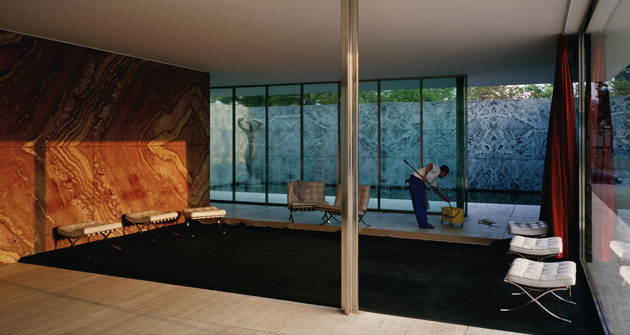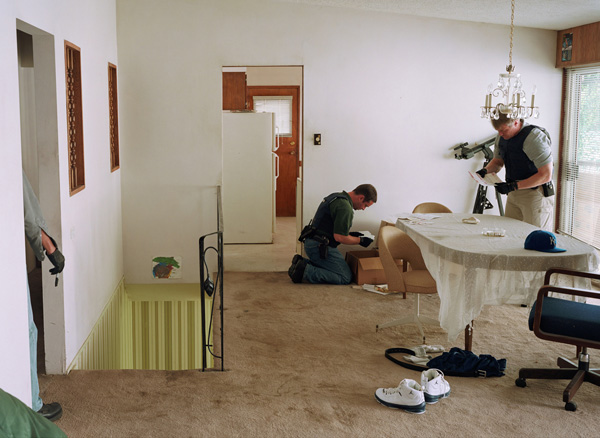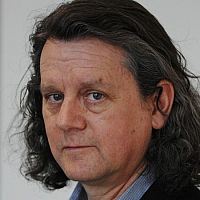
Morning Cleaning, Mies van der Rohe Foundation, Barcelona 1999 Transparency in light box 187 x 351 cm © Jeff Wall
Staatliche Kunstsammlungen Dresden Residenzschloss Taschenberg 2 01067 Dresden Allemagne
On the occasion of the reopening of the Albertinum, the Kunsthalle in the Lipsius building is displaying works by Jeff Wall, one of the most important photographers of the twentieth and twenty-first centuries. Close by the Albertinum, which shows art from Romanticism to the present, the exhibition will shine a bright light on contemporary art. Until Jeff Wall became one of the first artists to work with light boxes, photography was displayed in black and white, in small formats, like prints. By adopting the style of advertising in his works, Wall revolutionised photography.
“We are very fortunate to be able to show Wall’s light boxes and photographs in Dresden. Not only do his works examine how we approach our cultural heritage, but, here, they are actually in a place which was the birthplace of photographic technology”, said the Director General of Staatliche Kunstsammlungen Dresden, Prof. Martin Roth today in Dresden.
The exhibition shows 26 pieces by the Canadian photo artist from Vancouver; an impressive figure considering Jeff Wall’s meticulous methods and limited number of works. There are examples of all three major groups of works in the Lipsius building: nineteen light boxes, six black-and-white photographs and one chromogenic colour print. They span 32 years of his work, from Doorpusher (1984) to his latest piece from 2009, Search of premises.
“I don’t have a personal relation to Dresden. But maybe my pictures can relate. The last 50 years have been dramatic in Dresden and people are disturbed by history. That’s also a subject of my pictures: being disturbed and going over and over history”, said Jeff Wall. In fact, subtle links can be found in the Dresden collection.
“The largest light box of those selected, entitled Restoration (1993), has connections to Dresden. It takes up the topic of reconstructing and preserving the past by restoring a monumental panoramic painting”, explained the director of the Galerie Neue Meister, Prof. Ulrich Bischoff.
The same is true of Morning Cleaning, showing the Mies van der Rohe German pavilion in Barcelona: the neat row of chairs has been pushed aside, there is fluff on the carpet and a cleaner is mopping the floor. Every morning, cultural heritage has to be set up again, from scratch.
The light box, with its documentary style, is one example of Jeff Wall’s “cinematographic” work. In it he fuses elements of photography, film and painting. Thus, the photographs are perfectly lit, reconstructed and extremely carefully planned. Often, digital montage is used to produce one seamless image composed of different versions, creating the impression of a freeze frame, like on a film set. In Dresden, however, his documentary works do also play a role.
The last large monographic display of Jeff Wall’s art was shown in Basel in 2004, while the Galerie Neue Meister put the Doorpusher on show as far back as 1995 alongside nineteenth and twentieth century paintings. Now, Transit, an evocative title, refers to fine transitions, whether between private and public life or between the city and the countryside.
Curator Mathias Wagner explained: “Yet Transit is also open-ended: an invitation or a hidden story for the viewer to complete. Jeff Wall’s work is not socially critical or political; his reflections take place through beauty.”

Search of premises
2009
Light Jet Print
192 x 263 cm
© Jeff Wall
Jeff Wall’s modern allegories are based on gestures, formulaic images and principles of compositions from the past. Many motifs come from European art history, of which Jeff Wall has an excellent knowledge, having studied art history. Thus, Storyteller refers to Edouard Manet’s Le déjeuner sur l'herbe, and the Doorpusher, with his stylised gesture of blessing, is reminiscent of Christ at the Last Supper.

